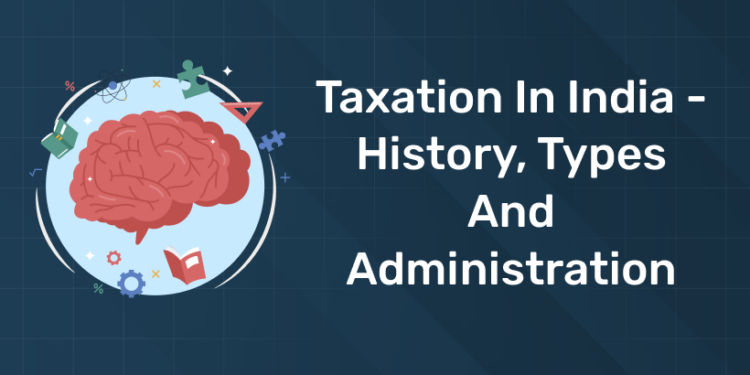Table of Contents
Income Tax Returns (ITR) might be a term we came across during the last couple of months, as the last date to file the ITR was 31st July. Taxation is a process through which nations collect money from their citizens or organizations to fund services and infrastructure. It’s a major source of revenue for governments and plays a critical role in the economy. Taxes are vital for funding essential services like education, healthcare, and public safety. Without proper tax collection, a government would struggle to maintain these services. A well-structured tax system is essential for nations to function smoothly and grow economically. Taxes are collected in any form, such as state taxes, central taxes, direct taxes, indirect taxes and more. In this blog, we’ll explore the tax system in India.
History of Taxation in India
The history of taxation in India dates back to ancient times. During the early days, taxes primarily consisted of offerings made to kings. Taxes on trade, agriculture, and professions are mentioned in the Arthashastra, an ancient Indian treatise on governance. During the Mughal period, the taxation system changed, and Akbar’s land revenue system became the foundation for modern tax administration.
During the British colonial era, significant modifications were implemented, including introducing direct taxes like income tax and indirect taxes like customs duties. A structured tax legislation attempt was implemented through the Indian Income Tax Act of 1860. Following independence, India adopted and modified these systems to suit its socio-economic conditions, leading to the comprehensive tax system in place today.
Types of taxes in India
1: Who was the first woman President of India?
Although there are several categories of taxes, the Tax system in India can be mainly classified into two types depending on how they are paid to the taxation authorities – Direct Tax and Indirect Tax.
Direct taxes are levied directly on the income or wealth of individuals or organizations and are administered by the Central Board of Direct Taxes (CBDT). Income Tax, Corporate Tax, Wealth Tax, and Capital Gains Tax fall under the category of direct taxes.
Indirect taxes are levied on goods and services and are collected by intermediaries from consumers. Taxes that fall under this category include Goods and Services Tax (GST), Customs Duty and Excise Duty.
Administration of Taxes in India
India’s tax administration is a collaborative effort between the central and state governments. The Central Government is responsible for administering taxes like income tax, corporate tax, customs duty, and central GST. The Central Board of Direct Taxes (CBDT) and the Central Board of Indirect Taxes and Customs (CBIC) are the main regulatory bodies.
Taxes like state GST, professional tax, and state excise duty are the responsibility of the respective state governments. The tax department of each state oversees the collection and management of these taxes.
Municipal Bodies levy local taxes such as property tax and water tax, which are crucial for funding local infrastructure and services.
GST
Goods and Services Tax (GST) is the most common tax we often see in our day-to-day life. It is one of the major tax reforms that was implemented in 2017. The introduction of GST streamlined indirect taxes, reducing the cascading effect and making compliance easier for businesses. It was introduced as the successor to VAT (Value-Added Tax).
Conclusion
Taxation, like every other nation, is an important part of India’s economy. It helps generate revenue, distribute wealth, and regulate the economy. Governments would struggle to maintain these services without proper tax collection. It is essential for both individuals and companies to understand the Indian tax system to navigate their financial obligations effectively.
Taxation in India – Quiz PDF
Download Russian Bolshevik Revolution – 1917 Quiz PDF for free!
Taxation in India – Quiz
- Which regulatory body administers direct taxes in India?
A. Board of Indirect Taxes and Customs (CBIC)
B. State Government
C. Central Board of Direct Taxes (CBDT)
D. Central Government
Ans: C – Central Board of Direct Taxes (CBDT)
- What type of tax is levied on goods and services in India?
A. Income Tax
B. Corporate Tax
C. Wealth Tax
D. Goods and Services Tax (GST)
Ans: D – Goods and Services Tax (GST)
- Who is responsible for administering customs duty in India?
A. Central Board of Direct Taxes (CBDT)
B. Central of Indirect Taxes and Customs (CBIC)
C. State Government
D. Central Government
Ans: B – Central of Indirect Taxes and Customs (CBIC)
- Which tax is directly imposed on the income or wealth of individuals or organizations in India?
A. Capital Gains Tax
B. Excise Duty
C. Wealth Tax
D. Income Tax
Ans: D – Income Tax
- When was GST introduced in India?
A. 2017
B. 2015
C. 2014
D. 2018
Ans: A – 2017
Frequently Asked Questions
What is the difference between direct and indirect taxes?
Direct taxes are levied directly on income or wealth, while indirect taxes are applied to the sale of goods and services.
How does GST differ from the previous indirect tax system?
GST unified various indirect taxes into a single tax structure, simplifying compliance for businesses.













